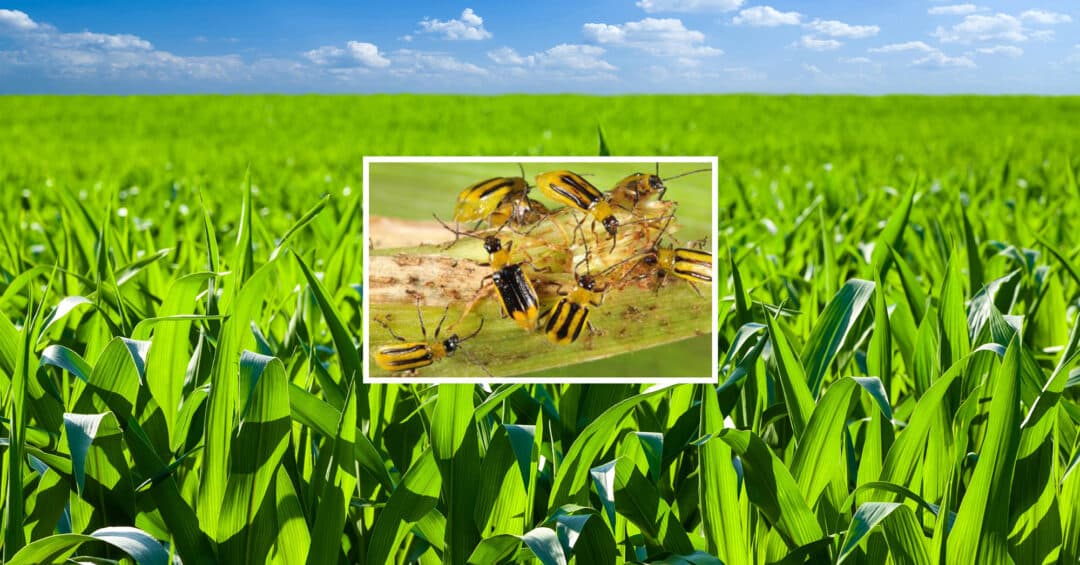

Photo of Western corn rootworm: Purdue Extension
Scientists sound the alarm over outdoor gene editing pesticides
by Claire Robinson | Jul 19, 2024
We’re used to gene editing being something that’s done in controlled and contained conditions in the lab, with just the final product being unleashed in the environment. But coming down the pipeline are pesticides designed to “edit” the genes of organisms out of doors, in the uncontrolled conditions of the open environment. Applied by spraying, irrigation, or via soil pellets, these outdoor-use genetic pesticides are claimed to be more environmentally friendly than chemical pesticides.
The problem is that these genetic pesticides could also “edit” the genes of what scientists call non-target organisms – i.e. people, animals, and insects in the environment could become collateral damage. “Editing” these organisms’ genes means silencing or disrupting their normal functioning. And the deregulation of gene editing that is occurring and being aggressively promoted around the globe means that these products could be used in open fields with no prior risk assessment, traceability, or monitoring.
Sounding the alarm about this “Wild West” scenario is a new study by an international team of scientists. The study, based on computer predictive modelling, found that exposure to a CRISPR/Cas gene-editing pesticide could unintentionally alter the genes of a wide assortment of non-target organisms, with potentially serious or even fatal consequences. And leading the list of potential victims of unintended gene editing are humans.
How the study was done
For their study, the scientists drew up a list of non-target organisms. They chose 18 species commonly found in farming environments, including humans, cattle, chickens, and mice; major crops – maize, soybeans, cotton, and common beans; wild plants; pollinator insects – two types of bee; predator insects; and soil organisms – earthworms and fungi – that cycle nutrients.
Then the scientists identified three major pests that look set to become targets of outdoor-use gene-editing pesticides: the Western corn rootworm, Red Flour Beetle, and the fungus Sclerotinia sclerotium. They selected genes that have been previously identified as a successful target for the CRISPR/Cas gene editing tool, making them probable targets for any genetic pesticide. Then, using publicly available computer software, they searched for matching genomic regions in the non-target species that would also be targeted by the CRISPR/Cas.
Exposures to target and non-target organisms could occur through contact, inhalation, or ingestion. The exposure methods modelled were irrigation, spraying (fumigation), or direct applications of pellets into soil (fertilisation).
Findings
The study found that unintended activity of the CRISPR/Cas gene-editing tool occurred in 12 out of the 18 species of non-target organisms investigated. The genomic regions affected included genes involved in the formation of the central nervous system in the honeybee to several pathways related to cancer and hormone metabolism in humans. In total, 155 metabolic pathways were affected the three exposure scenarios in the 12 species, with the majority of hits in the human genome.
The authors point out that such “Unintended activity could result in significant biological effects in all non-target plants and animals examined, such as the effects on immune responses, essential molecule biosynthesis, and the central nervous system. These results, consistent with existing literature on editing techniques, provide a clear rationale for the need to evaluate vulnerable NTOs [non-target organisms] in any proposed use of spray or topical techniques in the environment.”
Among eight non-target species (humans, cattle, chickens, mice, maize, soybeans, switchgrass, and sorghum), the number of potential unintended target genomic sites ranged from one in soybean and sorghum to 16 in humans. Humans were the most likely to be affected by exposure to a CRISPR/Cas pesticide in irrigation water.
Implications
Neither the relatedness of the target to the non-target organism nor even the biological kingdom of the non-target organism were able to predict the likelihood of unintended activity of the gene-editing tool. Therefore, the authors conclude, all species of concern may have to be specifically examined in a risk assessment.
Lead author of the study Sarah Agapito-Tenfen told GMWatch: ”The likelihood of identifying such unintended effects is directly linked to the availability of genomic databases for the non-target organism species. And because there is no complete database for all relevant non-target organism species, studies underestimate the real impact of genetic pesticides applications. This scientific uncertainty should not be used as an excuse to exempt genetic pesticides from holistic environmental risk assessment.”
The authors explain that non-target organisms have historically not been a focus in GMO risk assessments because the genetic engineering was performed on the intended organism in a laboratory that minimised the potential for non-target organisms to be exposed to the gene-modifying procedures. However, deregulation of genetic engineering processes, as is being proposed in some regions, including the EU and New Zealand, “would make it possible to use them in either built or open environments that do not control for exposures or for the release of organisms modified following an unintended exposure”.
Commenting on the study, molecular geneticist Prof Michael Antoniou said: “If these gene-editing pesticides come to market, as anticipated, they will be used in vast amounts on millions of hectares, making the likelihood of off-target organisms being affected a certainty – and that likelihood will increase over time.”
It’s crucial that governments and regulators take seriously the risks of outdoor use genetic pesticides and do not allow them to slip under the regulatory radar based on lobbyists’ false claims about the supposed naturalness of gene editing.
Subscribe to GMWatch
Notes:
Predicted multispecies unintended effects from outdoor genome editing
Aline Martins Hoepers, Jack A. Heinemann, Caroline Bedin Zanatta, Philomena Chu, Tessa C. Hiscox, Sarah Zanon Agapito-Tenfen
Ecotoxicology and Environmental Safety 282, 1 September 2024, 116707.
https://www.sciencedirect.com/science/article/pii/S0147651324007838#bib25 (open access)
Highlights
* New products for outdoor use of genome editing may be available soon. and cannot control exposures to non-target organisms.
* We use the same in-silico tools used to predict efficacy to assess potential unintended genome editing.
* Phylogeny was not predictive of likelihood of unintended effects in non-target species.
* Exposure to CRISPR/Cas pesticide could unintentionally alter the genomes of an assortment of non-target organisms.
* Metabolic enrichment analysis confirms the potential for unintended effects to cause adverse effects in non-target organisms.
Abstract
CRISPR/Cas9, a potent genetic engineering tool widely adopted in agriculture, is capable of introducing new characteristics into plants on a large scale and without conventional breeding methods. Despite its remarkable efficiency, concerns have arisen regarding unintended consequences in uncontrolled environments. Our aim was to assess potential activity in organisms that could be exposed to genome editing in uncontrolled environments. We developed three scenarios, using irrigation, fumigation and fertilization as delivery methods, based on outdoor uses in agriculture, namely pest and disease control. Using publicly available software (Cas-OFFinder, NCBI Genome Data Viewer and STRING), off-target effects were predicted in multiple species commonly found in the agroecosystem, including humans (16 of 38 (42 %) sampled). Metabolic enrichment analysis (gene IDs), by connecting off-target genes into a physiological network, predicted effects on the development of nervous and respiratory systems. Our findings emphasize the importance of exercising caution when considering the use of this genome editing in uncontrolled environments. Unintended genomic alterations may occur in unintended organisms, underscoring the significance of understanding potential hazards and implementing safety measures to protect human health and the environment.





Since this “study” is a prediction based on estimates, my question is, how does this “CRISPR” process actually work, and is it something that can work by mass spraying or otherwise exposing organisms to a substance? Is there an account of genetic damage from such an operation, or is it speculation?